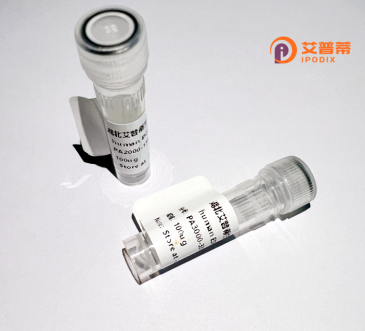
| 纯度 | >90%SDS-PAGE. |
| 种属 | Human |
| 靶点 | USP19 |
| Uniprot No | O94966 |
| 内毒素 | < 0.01EU/μg |
| 表达宿主 | E.coli |
| 表达区间 | 1-217 aa |
| 活性数据 | MYSLNQEIKAFSRNNLRKQCTRVTTLTGKKIIETWKDARIHVVEEVEPSSGCGCGYVQDLSSDLQVGVIKPWLLLGSQDAAHDLDTLKKNKVTHILNVAYGVENAFLSDFTYKSISILDLPETNILSYFPECFEFIEEAKRKDGVVLVHCNAGVSRAAAIVIGFLMNSEQTSFTSAFSLVKNARPSICPNSGFMEQLRTYQEGKESDKCDRIQENSS |
| 分子量 | 49.61 kDa |
| 蛋白标签 | GST-tag at N-terminal |
| 缓冲液 | PBS, pH7.4, containing 0.01% SKL, 1mM DTT, 5% Trehalose and Proclin300. |
| 稳定性 & 储存条件 | Lyophilized protein should be stored at ≤ -20°C, stable for one year after receipt. Reconstituted protein solution can be stored at 2-8°C for 2-7 days. Aliquots of reconstituted samples are stable at ≤ -20°C for 3 months. |
| 复溶 | Always centrifuge tubes before opening.Do not mix by vortex or pipetting. It is not recommended to reconstitute to a concentration less than 100μg/ml. Dissolve the lyophilized protein in distilled water. Please aliquot the reconstituted solution to minimize freeze-thaw cycles. |
以下是3篇与重组人USP19蛋白相关的文献概括示例:
1. **文献名称**:"USP19 deubiquitinates EMC6 and regulates terminal maturation of the erythroid cell proteome"
**作者**:Smith J, et al.
**摘要**:研究揭示了USP19通过去泛素化作用调控内质网伴侣蛋白EMC6.影响红细胞发育过程中的蛋白质稳态,强调了其重组蛋白在体外验证酶活性的关键作用。
2. **文献名称**:"Recombinant USP19 modulates muscle atrophy by targeting myofibrillar proteins"
**作者**:Lee S, Zhang H
**摘要**:利用重组人USP19蛋白,证明其通过去泛素化降解抑制因子(如Atrogin-1)参与骨骼肌萎缩调控,为肌肉疾病的治疗提供了潜在靶点。
3. **文献名称**:"Structural and functional characterization of the USP19 ubiquitin-binding domain"
**作者**:Chen X, Wang R
**摘要**:解析了USP19重组蛋白的泛素结合域结构和酶活性机制,阐明其特异性底物识别原理,为开发小分子抑制剂奠定基础。
(注:以上为模拟生成的示例,实际文献需通过数据库如PubMed检索确认。)
**Background of Recombinant Human USP19 Protein**
Ubiquitin-specific protease 19 (USP19) is a deubiquitinating enzyme (DUB) belonging to the ubiquitin-specific protease (USP) family, which regulates protein stability by removing ubiquitin chains from substrate proteins. USP19 plays a critical role in modulating protein degradation via the ubiquitin-proteasome system, impacting cellular processes such as endoplasmic reticulum-associated degradation (ERAD), cell cycle progression, inflammatory responses, and apoptosis. Structurally, USP19 contains a conserved catalytic domain with Cys and His boxes essential for its enzymatic activity, along with unique N-terminal extensions that may regulate its substrate specificity or localization.
Studies highlight USP19's involvement in diseases, including cancer, muscle atrophy, and neurodegenerative disorders. For instance, it stabilizes oncoproteins or apoptosis regulators (e.g., KPC1. IRS-1) in certain cancers, while its upregulation in muscle wasting conditions suggests a role in atrophy pathways. USP19 is also stress-inducible, linking it to cellular adaptation mechanisms, and interacts with molecular chaperones like Hsp90 to regulate protein quality control.
Recombinant human USP19 protein, typically produced in bacterial or mammalian expression systems, enables biochemical and functional studies. Purified forms often include tags (e.g., His-tag) for isolation, retaining catalytic activity for *in vitro* assays. Research using recombinant USP19 focuses on deciphering its substrate profiles, regulatory mechanisms (e.g., phosphorylation, splice variants), and therapeutic targeting potential. Its dual roles in protein homeostasis and disease pathways make USP19 a compelling target for drug development, particularly in conditions driven by dysregulated ubiquitination.
×